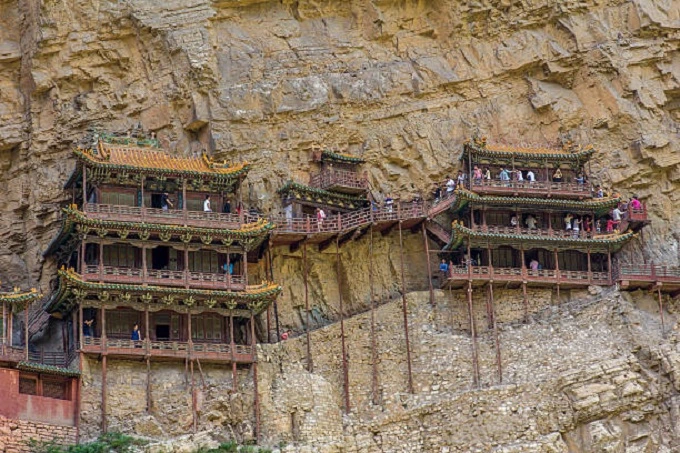In China, the Hanging Temple or Hengshan Hanging Temple defies gravity by hanging 75 meters above the ground near Mount Heng in Hunyuan County, Datong City, Shanxi Province, China. It has been there for 1,500 years, and it has been immaculately preserved to this day.
Ancient Chinese architecture is undoubtedly one of the most significant examples of architecture from any time anywhere in the world. These magnificent old structures have significantly influenced the architectural styles of practically every nation in East Asia, leaving behind a cultural and historical legacy that we value today.
Ancient Chinese architectural styles were responsible for constructing many of China’s most famous landmarks, including the Mausoleum of the First Qin Emperor, the Great Wall of China, and the Forbidden City. These structures have been a national pride for China for hundreds of years.
Although each of China’s many wonders possesses its own unique allure and splendor, there is one that very literally dominates the competition. The Hanging Monastery is an incredible example of Chinese architecture and can be found in Shanxi, around 60 kilometers southwest of Datong.
The Hanging Temple of Xuankongsi defies the laws of gravity by dangling precariously from the side of Mount Hengshan at an altitude of 75 meters above the ground, making it, unlike any other location you have ever visited.
It was erected in 491 AD and has lasted for over 1500 years, withstanding devastating storms and winds for over 15 centuries. In addition to having a stunning appearance, it is also a feat of engineering due to the fact that it was constructed at that time. Even more fascinating, legend has it that just one person originally built the temple, a monk named Liaoran, during the Wei Dynasty period (386-584 AD).
The vertical poles that you see in the photographs did not originally exist. They weren’t constructed until later ages, primarily because of the fact that too many people were too terrified to construct them in earlier centuries. Even with all of the modern technology and advanced construction methods, it would be quite tough to build something like the Hanging Temple today, and we can only imagine how difficult it would have been to build something like the Hanging Temple 1500 years ago.
The prevention of flooding was one of the primary considerations that led to the construction of Xuankongsi on a rock that was situated high above the ground. In addition to this, the top of Mount Hengshan shields it from the harsh weather brought on by snow and rain. Additionally, the neighboring mountains provide much-required shade from the intense sunlight.
Because of its significant role in the history of religion, the Hanging Temple is well-known all over the world. The fact that it is the only temple in China to symbolize all three of China’s major religions—Buddhism, Confucianism, and Taoism—sets it apart from other temples in terms of its spiritual beliefs.
Representing the three major religions of China had its benefits and is the primary reason why the temple remained untouched by various armies for 1500 years.
The length of the hanging temple is 35 meters, and it is made up of forty different halls, two pavilions (the South Pavilion and the North Pavilion), and a bridge that connects the two pavilions. There are eighty statues of various religious figures adorning the halls; for example, there are statues of Shakyamuni, Confucius, and Lao Tzu in one of the rooms. The largest hall and the tallest sculpture are in the South Pavilion, while the statues of Sakyamuni, Confucius, and Lao Tzu are in the North Pavilion.
The monastery has seen a great deal of expansion over several centuries, particularly in the 1500s. This combination of history, culture, and religion is the ideal representation of the accomplishments and glory of the Chinese people because it combines all three aspects. These days, the Hanging Temple is a tourist attraction in the Datong area, and it is a place that people from all over the world flock to in large numbers.
